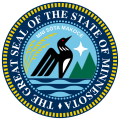1896 election in Minnesota
| |||||||||||||||||
| |||||||||||||||||
| |||||||||||||||||
The 1896 Minnesota lieutenant gubernatorial election was held on November 3, 1896, in order to elect the Lieutenant Governor of Minnesota. Republican nominee and incumbent member of the Minnesota House of Representatives John L. Gibbs defeated Democratic-People's nominee James Madison Bowler and Prohibition nominee Clarence Wedge. [1]


